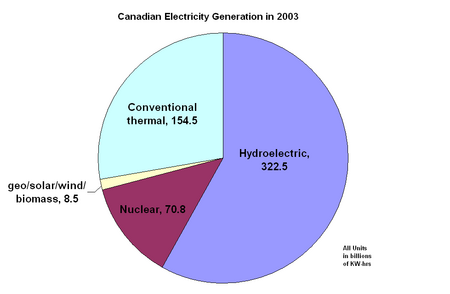
Québec is the number one producer of hydroelectricity in Canada. It also boasts one of the largest hydroelectric plants in the world, the Complexe La Grande near Baie James in the North of Québec. Hydro power represents 93% of the electricity sold and 97% of the energy produced in Québec.
This abundant and inexpensive energy source is safe for the atmosphere and gives Québec a distinct competitive edge in the North American energy market. Among other things, it constitutes a draw for companies in the electrochemical and electrometallurgical sectors.
James Bay Project
The James Bay Project, located in the Canadian province of Quebec, is testimony to the engineering skills of Hydro Quebec. Taken up in 1972, the phase I of the project consisting of three generating stations added more than 10000 MW of installed capacity to Quebec's power grid by 1985. The second phase of the project, which involves construction of six more generating stations, is to add another 5000 MW of capacity. Of this, four have already been commissioned. (The fifth, Laforge-2 is scheduled to be completed next year while the sixth, Eastmain 1, is on hold.) The La Grande 2 generating station, completed under phase I, is one of the World's largest power stations in terms of installed capacity (5328 MW).
The project makes use of the 548-metre drop between the source and mouth of the La Grande River and the average flow of 1700 cubic metres per second. The flow was doubled by diverting the waters of two adjacent rivers, Eastmain and Opinaca, into La Grande.
Idukki Project
The Idukki hydroelectric project is located on the Western Ghats of the Indian Peninsula at an altitude of 695 metres above the sea level. The reservoir is formed by three dams-- an arch dam across the Periyar River and a concrete dam across the Cheruthony River and a masonry dam at Kulamavu, upstream of Idukki. The reservoir covers nearly 60 square kilometres and has a catchment of 649 square km. Water from the reservoir is taken down to the underground powerhouse at Moolamattom through an underground tunnel, yielding an average gross head of 2182 feet (665 metres). The project has an installed capacity of 780 MW with firm power potential of 230 MW at 100 per cent load factor.
The project involved diversion of the waters of upper part of Periyar into the Muvattupuzha River.
Effects
- Severe drought in areas down stream of the river in summer and reduced fresh water availability for industries located near the mouth of the river due to diversion of water.
- Hundreds of tremours had been recorded in the Idukki area after the impounding of the dam and most of them are classified as reservoir induced. So far, these tremours have not caused any serious damage
- Valley slumpings and slope failures became common in the area following construction of the dam due to destruction of the forests during and after the construction. The project opened up the inner forests of Idukki district. This accelerated migration to the area, with the work force of around 6000 itself acting as the nucleus.
- Submerged about 6475 hectares of evergreen and deciduous tropical forests.
- Construction of roads, cutting of trees and encroachments led to loss of about 2700 hectares of forests and degradation of the remaining forests. Much of the degradation of forests that has happened over the years is irreversible. During the first phase of the Idukki project, dense vegetation cover in the surrounding areas went down by 56 per cent and sparse vegetation cover by 37 per cent. The area under agriculture increased by 126 per cent. (extent of encroachments that had taken place over the years).
- Owing to loss of habitat, some reptilian species like the rare terrapin has become extinct or sparse. The reservoir attracted some species of birds, but the number of some other species went down.
References:
Comparative Study of Hydroelectric Projects in Canada and India: http://expert-eyes.org/canada.html
No comments:
Post a Comment